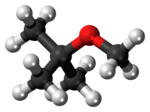Methyl tert-butyl ether
 | |
 | |
| Names | |
|---|---|
| IUPAC name
2-Methoxy-2-methylpropane | |
| Other names
Methyl tertiary-butyl ether; Methyl tert-butyl ether; Methyl t-butyl ether; MTBE; tert-Butyl methyl ether; tBME; tert-BuOMe | |
| Identifiers | |
| 1634-04-4 | |
| 3D model (Jmol) | Interactive image |
| ChEBI | CHEBI:27642 |
| ChemSpider | 14672 |
| ECHA InfoCard | 100.015.140 |
| KEGG | C11344 |
| PubChem | 15413 |
| |
| |
| Properties | |
| C5H12O | |
| Molar mass | 88.15 g·mol−1 |
| Density | 0.7404 g/cm³ |
| Melting point | −109 °C (−164 °F; 164 K) |
| Boiling point | 55.2 °C (131.4 °F; 328.3 K) |
| 26 g/L (20 °C)[1] | |
| Viscosity | 0.36 cP at 25 °C |
| Hazards | |
| NFPA 704 | |
| Flash point | −10 °C (14 °F; 263 K) |
| Except where otherwise noted, data are given for materials in their standard state (at 25 °C [77 °F], 100 kPa). | |
| | |
| Infobox references | |
Methyl tert-butyl ether (also known as MTBE and tert-butyl methyl ether) is an organic compound with molecular formula (CH3)3COCH3. MTBE is a volatile, flammable, and colorless liquid that is sparingly soluble[1] in water. It has a minty odor vaguely reminiscent of diethyl ether, leading to unpleasant taste and odor in water. MTBE is a gasoline additive, used as an oxygenate to raise the octane number. Its use is controversial because of its contamination of groundwater and legislation favoring ethanol. However, worldwide production of MTBE has been constant owing to growth in Asian markets.[2]
Production and properties
MTBE is manufactured via the chemical reaction of methanol and isobutylene. Methanol is derived from natural gas, and isobutylene is derived from butane obtained from crude oil or natural gas, thus MTBE is derived from fossil fuels. In the United States, it is produced in very large quantities (more than 200,000 barrels (32,000 m3) per day in 1999) during its use as a fuel additive.
Uses
MTBE is used as a fuel component in fuel for gasoline engines. It is one of a group of chemicals commonly known as oxygenates because they raise the oxygen content of gasoline.
As anti-knocking agent
In the US it has been used in gasoline at low levels since 1979 to replace tetraethyl lead and to increase its octane rating helping prevent engine knocking. Oxygenates help gasoline burn more completely, reducing tailpipe emissions from pre-1984 motor vehicles; dilutes or displaces gasoline components such as aromatics (e.g., benzene) and sulfur; and optimizes the oxidation during combustion. Before the incoming of other oxygenates and octane enhancing components most refiners had chosen MTBE primarily for its blending characteristics and low cost.
Alternatives to MTBE as an anti-knock agent
Other oxygenates are available as additives for gasoline including ethanol and other ethers such as ETBE.
Ethanol has been advertised as a safe alternative by agricultural and other interest groups in the US and Europe. In 2003, California was the first US state to start replacing MTBE with ethanol.
An alternative to ethanol is ETBE, which is manufactured from ethanol and isobutene. Its performance as an additive is similar to MTBE, but due to the higher price of ethanol compared to methanol, it is more expensive.
Higher quality gasoline is also an alternative, so that additives such as MTBE are unnecessary. Iso-octane itself is used. MTBE plants can be retrofitted to produce iso-octane from isobutylene.[3][4]
As a solvent
MTBE is extensively used in industry as a safer alternative to diethyl ether (which is commonly used in academic research) as the tert-butyl group prevents MTBE from forming potentially explosive peroxides. It is also used as a solvent in academic research,[5][6][7] although it is less commonly used than diethyl ether. Although an ether, MTBE is a poor Lewis base and does not support formation of Grignard reagents. It is also unstable toward strong acids. It reacts dangerously with bromine.[8]
MTBE forms azeotropes with water (52.6 °C; 96.5% MTBE)[9] and methanol (51.3 °C; 68.6% MTBE).[10]
A solvent for gallstones
In a procedure called contact dissolution therapy, MTBE is injected directly into the gallbladder to dissolve gallstones.[11][12]
Persistence and pervasiveness in the environment
MTBE gives water an unpleasant taste at very low concentrations, and thus can render large quantities of groundwater undrinkable. MTBE is often introduced into water-supply aquifers by leaking underground storage tanks (USTs) at gasoline stations or by gasoline containing MTBE spilled onto the ground. The higher water solubility and persistence of MTBE cause it to travel faster and farther than many other components of gasoline when released into an aquifer.[13][14]
MTBE is biodegraded by the action of bacteria. In the proper type of bioreactor, such as a fluidized bed bioreactor, MTBE can be rapidly and economically removed from water to undetectable levels. Activated carbon produced from coconut shells and optimized for MTBE adsorption may reduce MTBE to undetectable levels,[15] although this level of reduction is likely only in the most ideal circumstances. There are currently no known published cases of any in-situ treatment method which has been capable of reducing contaminant concentrations to baseline (pre-development) conditions within the aquifer soil matrix itself.
According to the IARC, a cancer research agency of the World Health Organization, MTBE is not classified as a human carcinogen. MTBE can be tasted in water at concentrations of 5 – 15 µg/l.[16]
As of 2007, researchers have limited data about the health effects of ingestion of MTBE. The United States Environmental Protection Agency (EPA) has concluded that available data are inadequate to quantify health risks of MTBE at low exposure levels in drinking water, but the data support the conclusion that MTBE is a potential human carcinogen at high doses.[17]
Legislation and litigation in the U.S.
MTBE removal from groundwater and soil contamination in the U.S. is estimated to cost from $1 billion[18] to $30 billion,[19] including removing the compound from aquifers and municipal water supplies and replacing leaky underground oil tanks. In one case, the cost to oil companies to clean up the MTBE in wells belonging to Santa Monica is estimated to exceed $200 million.[20] In another case, the City of New York estimated a $250 million cost for cleanup of a single wellfield in Queens, NY.[21] More recently, a jury awarded the State of New Hampshire $236 million in damages[22] in order to treat groundwater contaminated by MTBE.
MTBE is now banned as a "fuel additive" in the US but is still legal for other industrial uses.[23]
In 2000, the U.S. EPA drafted plans to phase out the use of MTBE nationwide over four years. As of 2016, still hundreds of lawsuits are still pending regarding MTBE contamination of public and private drinking water supplies.
The Energy Policy Act of 2005, passed in the U.S. House of Representatives, did not include a provision for shielding MTBE manufacturers from water contamination lawsuits. This provision was first proposed in 2003 and had been thought by some to be a priority of Tom DeLay and Rep. Joe Barton, then chairman of the Energy and Commerce Committee.[24] This bill did include a provision that gives MTBE makers, including some major oil companies, $2 billion in transition assistance while MTBE was phased out over the next nine years.[25] Due to opposition in the Senate,[26] the conference report dropped all MTBE provisions. The final bill was passed by both houses and signed into law by President Bush.[27] The lack of MTBE liability protection is resulting in a switchover to the use of ethanol as a gasoline additive.
The U.S. EPA currently lists MTBE as a candidate for a maximum contaminant level (MCL) in drinking water.[28] MCLs are determined by the EPA using toxicity data.
See also
- Cyclopentyl methyl ether (CPME)
- Ethyl tert-butyl ether (ETBE)
- tert-Amyl methyl ether (TAME)
- Tetraethyl lead (TEL)
References
- 1 2 Record in the GESTIS Substance Database of the IFA
- ↑ M. Winterberg, E. Schulte-Korne, U. Peters, F. Nierlich "Methyl Tert-Butyl Ether" in Ullmann's Encyclopedia of Industrial Chemistry, 2010, Wiley-VCH, Weinheim. doi:10.1002/14356007.a16_543.pub2
- ↑ http://www.nesteengineering.com/default.asp?path=111,360,362,477 Archived January 6, 2006, at the Wayback Machine.
- ↑ http://www.halliburton.com/kbr/hydroChem/petroChem/nexoctane.jsp
- ↑ Matyash, V.; Liebisch, G.; Kurzchalia, T. V.; Shevchenko, A.; Schwudke, D. (2008). "Lipid extraction by methyl-tert-butyl ether for high-throughput lipidomics". The Journal of Lipid Research. 49 (5): 1137. doi:10.1194/jlr.D700041-JLR200.
- ↑ Vopička, Ondřej; Pilnáček, Kryštof; Číhal, Petr; Friess, Karel (2016-03-01). "Sorption of methanol, dimethyl carbonate, methyl acetate, and acetone vapors in CTA and PTMSP: General findings from the GAB Analysis". Journal of Polymer Science Part B: Polymer Physics. 54 (5): 561–569. doi:10.1002/polb.23945. ISSN 1099-0488.
- ↑ Vopička, Ondřej; Radotínský, Daniel; Friess, Karel (2016-02-01). "Sorption of vapour mixtures of methanol and dimethyl carbonate in PTMSP: Cooperative and competitive sorption in one system". European Polymer Journal. 75: 243–250. doi:10.1016/j.eurpolymj.2015.12.015.
- ↑ "Interaction between bromine and tert-butyl methyl ether". Retrieved 13 May 2010.
- ↑ Zeon Corporation
- ↑ CRC Handbook of Chemistry and Physics, 90th edition
- ↑ Schoenfield LJ, Marks JW (1993). "Oral and contact dissolution of gallstones". Am. J. Surg. 165 (4): 427–30. PMID 8480875.
- ↑ "Health Guide: Gallstones". New York Times.
- ↑ http://www.handpmg.com/lustline31-mtbe-or-benzene.htm
- ↑ San Francisco Bay Area Regional Water Quality Control Board Integrated Basin Management Plan (2004)
- ↑ link text
- ↑ Fischer A, Oehm C, Selle M, Werner P (2005). "Biotic and abiotic transformations of methyl tertiary butyl ether (MTBE)". Environ Sci Pollut Res Int. 12 (6): 381–6. doi:10.1065/espr2005.08.277. PMID 16305145.
- ↑ http://www.epa.gov/mtbe/faq.htm#concerns
- ↑ SIGMA - Weekly Report
- ↑ Long Island Utility Fighting to Defeat MTBE Safe Harbor - Napoli Bern - Attorneys
- ↑ AmeriScan: February 17, 2005
- ↑ Navarro, Mireya (2009-10-20). "City Awarded $105 Million in Exxon Mobil Lawsuit". The New York Times. Retrieved 2010-05-12.
- ↑ Earle, Sarah (2013-04-09). "Exxon Mobil is Found Negligent in New Hampshire MTBE Use". Bloomberg. Retrieved 2013-04-09.
- ↑ Art 16 NY Ag & Markets law § 192-g
- ↑ http://www.cnn.com/2005/POLITICS/04/21/energy.bill.mtbe.ap/
- ↑ http://www.msnbc.msn.com/id/7574562/+MTBE&hl=en
- ↑ Charles Babington, House Again Passes GOP Energy Measures, Washington Post, June 16, 2004, at A4 (House passes Energy Bill, but Senate opponents of MTBE provision in House Bill have the votes to prevent its enactment).
- ↑ http://thomas.loc.gov/cgi-bin/bdquery/z?d109:h.r.00006:
- ↑ CCL 2 List
External links
- MTBE in Europe
- MTBE webpage from the EPA
- Summary of health effects data from IACR
- Eliminating MTBE in Gasoline in 2006 (pdf)
- An online resource about MTBE litigation and the surrounding issues
- MTBE: What The Oil Companies Knew And When They Knew It (from the Environmental Working Group)
- MTBE Resource Guide
- European Union MTBE Risk Assessment Report
- Fuel Quality Directive Impact Assessment
- Council Directive 85/536/EEC of 5 December 1985 on crude-oil savings through the use of substitute fuel components in petrol
- An assessment of the impact of ethanol-blended petrol on the total NMVOC emission from road transport in selected countries
